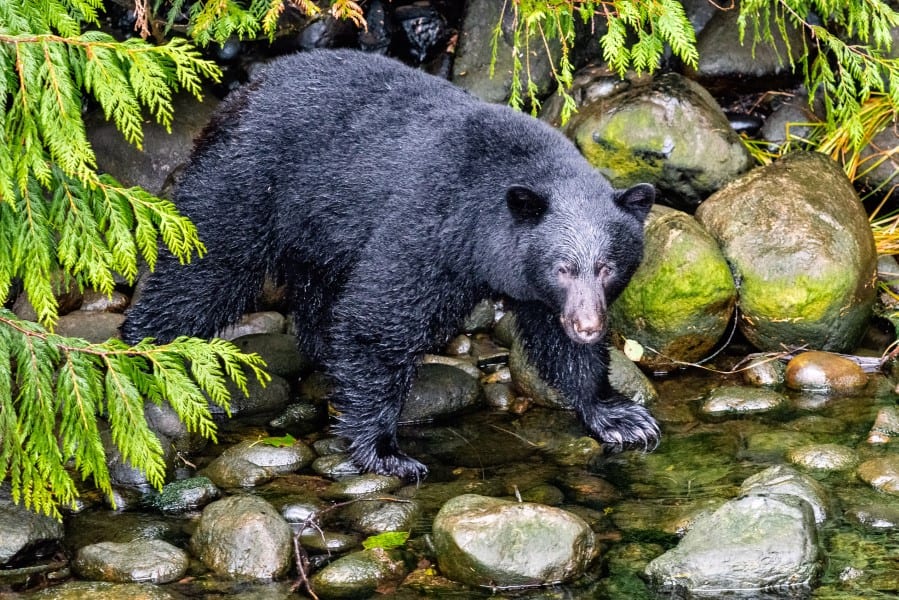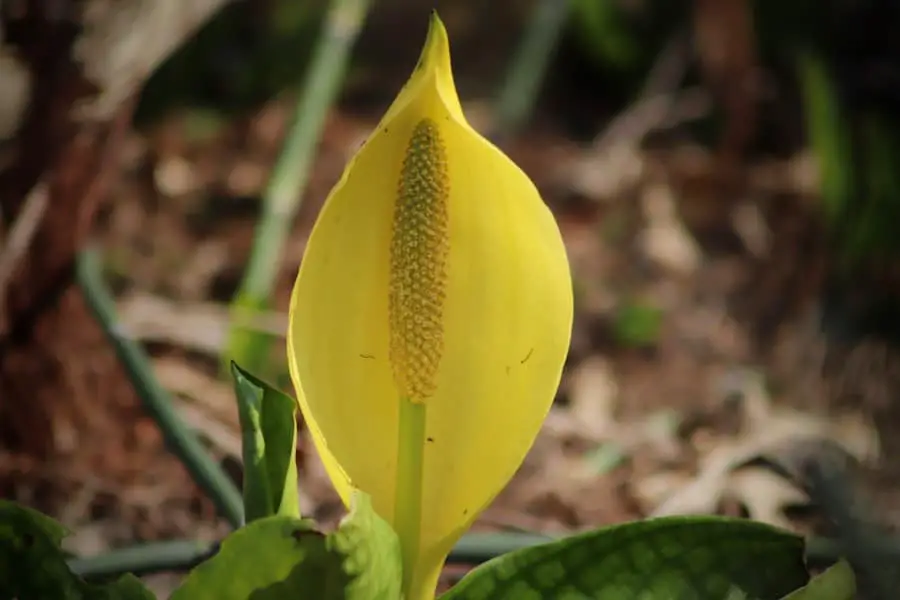We think of North American black bears as being ferocious hunters and killers! But the truth is their diets vary a lot and it’s not all meat. So in this article, we’re going to cover what black bears eat, and their diet through each of the seasons.
But let’s start with a quick round-up answer, then we’ll dive into more details…
What Do Black Bears Eat? Black bears are omnivores that eat both plants and animals. But their diet depends heavily on seasons and availability of food. In spring they feed more on sprouting plants, whereas in summer they hunt more. In fall they eat any suitable food they find (hyperphagia) and in winter they barely eat.
North American Black bears are classified into the order of carnivores. But black bears are essentially omnivores that have a diet varying from plants, insects, fish, and animals.
To be more specific, as ferocious as they might seem, a black bear’s diet consists of 90 percent of plant foods.
A black bear and its diet vary mainly because these creatures have a patchwork of habitats throughout the year in the wild because of different seasons and so their food and their diet changes accordingly.
In fact, they’re perfectly adapted to a varied diet. They’re intelligent enough to be able to assess what food is edible, they have to tools (claws and teeth) at their disposal to be able to unearth, bring down and forage for a multitude of different food types, as well as the mental capacity to know where food will be at specific times of the year.
So Black bears are able to develop a complex map of each season and where to go to locate specific food sources.
With that information set in, let’s go on to provide a clear overview of what black bears eat and how seasons interestingly affect their diet.

Black bear diet in spring
In spring when bears finally come out of their dens after hibernation looking thinner and feeling weaker, food is usually short in supply.
Even if bears are super hungry during this season, they barely have anything to feed on in the wild. This is because plants won’t leaf for a month or two and the only available source of food for bears are grasses at lower elevations that have just begun to grow.
And at lower elevations, during spring even dandelions make a great snack for black bears. During spring dandelions especially make up a large portion of a black bear’s diet, as they contain high nutritional value.
The skunk cabbage is also another special food for bears during spring. Black bears are one of those few animals that will tackle skunk cabbage.
Skunk cabbage as the name suggests is very unappealing. It also leaves a burning sensation in the mouth of most animals. North American Black Bears …or bears in general feed on skunk cabbage right as it sprouts in the spring. This special timing helps black bears avoid the discomfort and provides them with a healthy happy snack.

Black bears also forage towards south-facing slopes searching for overwintered berries. Some black bears move towards open wetland meadows. This is where first green grasses and sedges often sprout right at the edge of streams, making it attractive to feed on.
Some black bears use their long sharp claws and strong shoulders to dig for sweet-vetch roots, glacier lily bulbs, and other starch-rich foods.
As such it’s pretty much plants that black bears usually feed on, or perhaps can find mostly during the early spring.
But meat is an important source of protein for many black bears. So black bears also forage along low elevation river-valleys. Here they try to find well-cured carcasses of salmon that died the previous fall after spawning. They also scavenge for winter-killed animals and carrion.
Since food is relatively more scarce during spring, black bears continue to lose weight. They keep on shedding weight well into June when summers sets in.
Back bear diet in summer
When summer sets in and the days lengthen, new greenery finally sprouts. This is a good time for black bears to feed on high energy food.
In early summer they’ll begin foraging in wet meadows, creeks and rivers, avalanche slopes and marshy edges – looking for pockets of greenery. Especially grass, black bears love grass which comprises most of their diet. During summer black bears also forage for ants and beetle larvae in fallen logs.
And it’s during summer black bears are fond of eating fungi. Indeed Fungi does often form part of a black bear’s diet, especially mushrooms. But it’s not often, it’s more likely that black bears are only “occasional” eaters of fungi.
It’s in late July or early august the first ripening of huckleberries, blueberries and other berries start. This ripening of berries draws the attention of bears.
Black bears devote plenty of time to exploiting this high energy food. Black bears can, in fact, consume 20,000 buffalo berries in a single day.
But what’s exciting about a black bear’s diet is the image we all think of with black bears. They reach into a beehive for both the honey …and the bees themselves, this provides a rich source of sugars and other nutrients during summer.
So now we all might agree that it’s not just “Winnie the pooh” that’s the only bear partial to a spot of honey!
But for black bears, summer is not all about berries and greenery. Summer is the perfect season where black bears hunt for meat too in order to boost their protein levels. Black bears love bovine such as cattle and moose.
Wild black bears can run pretty fast and they’re well known for hunting moose.
They might even spend a couple of days eating an adult moose compared to the 40 minutes they take to eat a caribou calf. They also hunt for beavers in summer which can get them a pretty tasty meal too. But beaver hunting is a rarely targeted prey for black bears – it’s more opportunistic kill.
Black bear diet in fall
This is a critical or perhaps a crazy season for black bears where they enter a state of Polyphagia. meaning a frenzied time for eating large volumes of food.
It’s this season where black bears attempt to pack themselves with enough food in order to put on weight as much as possible – as a way of preparing for their long winter sleep.
At this time when food supplies begin to dwindle, black bears pretty much feed on even the tiniest reliable food source in the wild. This includes ants, insects, and even seeds.
Although it may sound like it’s not worth it for an animal as large as a black bear to feed on insects, they do indeed, and it all adds to their protein intake and weight. They feed on these especially when their food options become scarce and they need to level up their protein intake.
Apart from insects, black bears also wander the landscape searching for greeneries and roots that still grow near water and streams. They also feed on “gut piles” – discarded animal parts or wounded animals left by hunters.
And black bears also feed on any eggs left in nests by birds – if it’s at within their reach. They will consume all they can as far as they can into fall, black bears pretty much consume anything that looks like a suitable source of food.
Black bear diet in winter
In winter around November and December, black bears return to their dens. But in lower latitude, where it’s warmer and food is available, black bears may not hibernate.
In fact, black bears in urban areas are forgoing hibernation, as they’ve learned that people provide good food throughout the winter period, like bird seeds, pet food (dog food) and of course garbage to add to the list.
But in the wild, black bears that do retire to and hibernate in their dens, will rarely eat or drink. But on occasion, black bears may leave their dens to feed on winter-killed animals when and if they need to, which is probably the only main source of food available during winter.
Educational resources
Further your education of bears in the wild, either at home or in school with the following resources that we’ve sourced as the best available on Amazon.
Bears Fun facts about our amazing bears
One of Us: A Biologist’s Walk Among Bears
Video resources
Why not continue your learning with this video on Black Bears taken in Yosemite Park.
So finally…
We hope this has been useful in understanding the diet of North American black bears in the wild. And throughout each of the seasons. Why not check out our other fabulous wildlife articles where we cover all kinds of wildlife and nature questions. Or leave a comment below, we’d love to hear from you.
This content has been checked and verified by a qualified veterinary practitioner. The article has been reviewed by our editorial board and has been approved for publication in accordance with our editorial policy.
